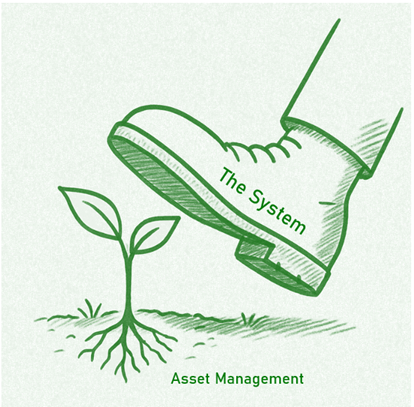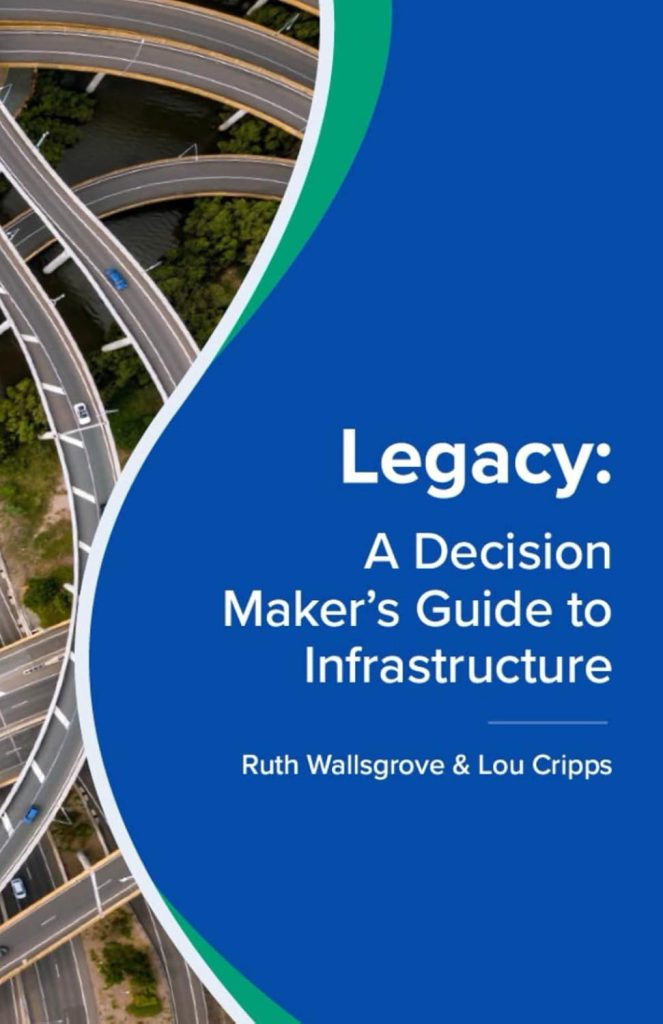
What is your legacy to infrastructure? Not the concrete you pour, but the quality of your decision-making.
Here’s an article on better decision thinking from Talking Infrastructure board member Lou Cripps for the Institute of Asset Management magazine.
https://publications.cplone.co.uk/portfolio/IAM/202507/0010.html
My last post examined Thomas Kuhn, who gave us the language of paradigm shifts, here, I’d like to look at a book by Michele Wucker* who gave us the image of the Gray Rhino: a massive, obvious threat we can see coming but still fail to confront.

Where Kuhn focused on how systems break and are replaced, Wucker draws attention to the crises we recognize but still choose to ignore.
Asset Management exists at the intersection of these two frameworks.
Asset-intensive organizations are surrounded by gray rhinos. Infrastructure gaps, aging systems, climate vulnerability, workforce attrition, regulatory pressure: these are not surprises. They are slow-moving, well-documented challenges that, if left unaddressed, will overwhelm the system we rely on.
Yet for all their visibility, these threats rarely trigger the level of change they demand. Instead, they are absorbed into routine. Budget cycles roll forward. Work orders are prioritized by urgency rather than consequence. The language of Asset Management is invoked, but its paradigm is never fully adopted. We name the problem but struggle to act on it.
Asset Management offers an approach precisely designed to engage these looming risks. It asks us to plan, to prioritize, to see beyond the emergency response. It invites organizations to realign their values, moving from reactive service delivery to deliberate, long-term stewardship.
But as Kuhn would note, this requires a change in the underlying logic, a shift in how organizations understand value, success, and time.
Until that shift happens, Asset Management remains vulnerable to reinterpretation. The system continues to operate within the old paradigm, where short-term efficiency trumps long-term value, and where the urgency of today erodes the preparation for tomorrow.
This is not a failure of awareness. It is a failure of transformation. We see the gray rhino, and we have a framework for responding to it. But our systems, both technical and cultural, are still optimized for a different reality.
So, what do we do with this tension?
We start by recognizing that paradigm shifts don’t come from force. They come from readiness.
And readiness grows in moments of discomfort, when the cracks in the current system become too wide to ignore. When organizations feel the weight of the gray rhino pressing closer, they become more open to doing things differently.
Asset Management must be positioned as more than a practice. It must become a way of seeing the world around us. Using a lens where the familiar takes on new meaning and is a guide for what to do when the warning signs are no longer abstract.
Most importantly, Asset Management needs its champions. People who can not only name the gray rhino and frame the conversation but offer a path forward that is both pragmatic and bold.
Change can be slow, but it is also inevitable. Those that prepare will be the ones best positioned when the shift finally takes hold.
The gray rhino is here. The question is whether you will continue to ignore it or finally take action to avoid being trampled.
*The Gray Rhino: How Recognize and Act on the Obvious Dangers We Ignore, Michele Wucker, 2016
This is a follow-up to Julie’s and my first post. This comes from discussions with Ruth, as we are both fans of Kuhn and approaching Asset Managment from a Systems Thinking bend.

Asset Management isn’t failing, but it is struggling. It’s struggling because it asks for something most organizations aren’t ready to give: a change in worldview.
In his seminal work The Structure of Scientific Revolutions, Thomas Kuhn argued that progress in science doesn’t move forward in smooth, logical steps. Instead, it lurches forward through upheaval.
An existing model, what Kuhn calls a paradigm, organizes how people understand and act in the world. When that model starts to break down under the weight of anomalies it can’t explain, a crisis forms. Eventually, a new model takes hold. Not by refining the old one, but by replacing it entirely.
Asset Management isn’t a toolkit upgrade. Asset Management is a paradigm shift.
The prevailing paradigm in many organizations see assets as cost centers. Value is measured in terms of budget variance, performance is gauged by how fast we respond to failure, and success means keeping operations running despite broken systems and shrinking resources. This is the logic of firefighting, not foresight.
Asset Management offers a radically different frame. It suggests we treat assets as value-producing systems. These decisions should be based not only on today’s conditions but on long-term impacts. That success means reducing failure, not merely reacting to it quickly. And that the ultimate responsibility of an organization is to deliver reliable, sustainable service—not just to manage budgets.
But here’s the problem, and Kuhn would recognize it: paradigms don’t go quietly. The existing mindset fights back. Asset Management is often taken in and translated through the old lens. We say we’ve adopted Asset Management, but we’re still rewarding short-term fixes. We talk about lifecycle value, but we still plan one year at a time. We build dashboards and risk models, but we still defer investment until failure forces our hand.
This is normal. According to Kuhn, when a new paradigm first appears, it doesn’t make sense within the old logic. People struggle to see its relevance. They may accept some of its tools, but not its worldview. The old questions remain, and the new answers seem off-topic.
Real change happens only when the organization starts asking new questions. Not just, “How do we save money this year?” but “What will this decision cost us over the next 30?” Not, “How fast did we respond to the outage?” but “Why did the outage happen at all?”
That’s when a shift begins.
A true Asset Management transformation doesn’t begin with data, or systems, or even leadership mandates. It begins with discomfort, when the old paradigm can no longer explain the failures piling up around us. When firefighting becomes too exhausting, too expensive, too visibly ineffective. Then, and only then, do people become open to a new way of thinking.
So, the task isn’t just to implement Asset Management. It’s to create the conditions where the old worldview can be questioned. That means:
- Telling stories that expose the cost of reactive practices
- Measuring success in ways that reward foresight
- Giving voice to people who see the long game
- Protecting Asset Management from being reinterpreted as just another compliance exercise
Paradigm shifts are hard. They are political, cultural, and emotional. But they are also the only way real progress happens. Asset Management doesn’t need to fight harder. It needs to be ready to lead when the cracks in the old system finally become too big to ignore. It needs to be there to offer a better forward.
Link to Ruth’s article: AM, Capital-ism and Shifting Paradigms | Talking Infrastructure

Here is another actual event demonstrating the immediate benefits of having an AM Plan.
Free gifts are never really free. This is why Joe Brown, the ageing art dealer, was finding it so difficult to get the Victorian Government to accept his offer of an outstanding art collection worth many millions of dollars. The capital and ongoing costs associated with housing and maintaining the collection were themselves quite extensive. The quality of the collection was not in dispute but what was in dispute was the value to the Victorian community of allocating scarce resources to an art collection, resources that could otherwise be spent on health or education or any of a large number of other uses.
The decision would, of course, be influenced by the Government’s strategy for community arts at the time, as well as the nature and extent of its existing portfolio. This AM information in the Plan would help to determine what this collection could add to the total art coverage. (Remember “All strategic questions are portfolio questions”)
The Strategy and associated plans were well documented, enabling the opportunity to acquire this collection to be compared with the existing methods of meeting the State’s Art and other strategies, as documented in the Plans. This made it possible to tell whether this was a ‘wanted’ or an ‘unwanted’ gift.
Without this information, elected members were at serious risk of being emotionally blackmailed into possibly poor community decisions. Protect your agency by protecting your elected members!
What other ways can you suggest to strengthen the case for AM Plans? Please share your experiences.

Lobbyists are the bane of a CEO’s life – and an Asset Manager’s! This presents another good use for an AM Plan. Unlike last week’s story where the council was well prepared with its AM Plan, in this instance it was not. But YOU could be!
The council members had been well educated in asset management thinking and were aware that the acquisition of an old, non-heritage listed building with limited functionality was not in the best interests of the community. But how did they deal with a small, but extremely vocal and active, lobby group that was pressing them to acquire it?
At this stage their asset management plan had not yet been constructed but suppose it was, then they could have shown the lobbyists that council’s resources were fully allocated to projects which had each been justified in terms of benefits and costs to the community and they could have said:
“We appreciate your interest but here is where council resources are going. All of these projects have been carefully analysed, costed and evaluated. Provide us with a costed evaluation and the benefits of your proposal for the wider community and if the benefit:cost analysis shows that it is better than the least of our current projects we will reconsider.”
This puts the onus back on the lobbyists to estimate both costs AND benefits and this will often be sufficient to stop the lobbying pressure but if the lobby group do demonstrate greater value then council knows that it is not disadvantaging the community by agreeing to their wishes.
Some many years later the Mornington Peninsula Shire Council in Victoria actively employed this approach – very successfully.
What experience have you had that would strengthen the short term benefits case for AM Plans?
Julie and I produced this after a recent discussion with Ruth. I think it’s a discussion we’ve been having for years.

Todd Shepherd & Julie DeYoung
Once upon a time, or so the story goes, Asset Management started to take sprout at our organizations with a bold promise. It came to guide us toward long-term thinking, to help us look beyond next year’s budget and into the decades ahead. It came with principles and frameworks, a philosophy that assets are not isolated items, but interconnected parts of a whole. The decisions we make today shape the quality of life for future generations. It was a different way of seeing how investing in the right place, at the right time, could save money, and public trust.
But then Asset Management met The System. And The System did what it always does: it absorbed the new idea and bent it back into something familiar.
Instead of being a strategy for long-term stewardship, Asset Management became a new label for what we were already doing. We turned it into a more refined version of the same habits: squeezing the last bit of life out of aging assets, reacting quickly to failures, and deferring investment until the next crisis hit. We framed these actions as efficiency, as cost savings, as smart business. But they were just survival tactics. And so, when Asset Management started to bloom, it was quietly, subtly, reshaped.
What was meant to be transformational became transactional.
Long-term planning? That would have to wait. We needed to fix the latest failure, explain the recent cost overrun, patch the emergency before the news cycle caught wind. The capital planning calendar was full of yesterday’s fires. Asset Management was drafted into service as a better way to react.
Rather than change The System, Asset Management was absorbed by it. It was translated into the language of short-term cost savings and immediate returns. “Get more life out of your assets” became a directive, not to optimize lifecycle value, but to defer replacement as long as humanly possible. And The System applauded. Budgets tightened. Work orders increased. Failure response times improved…until they didn’t.
This isn’t a failure of individuals. It’s what happens when a new idea runs headlong into The System. The System reward firefighting over fire prevention. It promotes leaders who solve today’s crises, not those who quietly prevent tomorrows. It allocates resources to what is visible, immediate, and politically expedient. And so, Asset Management is quietly reshaped until it fits.
A discipline focused on resilience and long-range value becomes a sophisticated way to do what we’ve always done: squeeze, stretch, defer, and repeat.
Asset Management, instead of being a disruptor, became domesticated.
The truth is, Asset Management requires a paradigm shift. It requires a new way of thinking about value, responsibility, and time. It asks us to see past short-term wins and start building for long-term resilience. It asks leaders to stop managing symptoms and start addressing root causes. It asks organizations to measure success not by how fast they respond to failure, but by how rarely failure occurs at all.
That’s a hard shift to make. It means unlearning habits, changing incentives, and having the patience to invest in what won’t pay off this quarter. It means making space for new voices, new metrics, and sometimes uncomfortable truths.
But if we want Asset Management to be more than a buzzword, we need to protect it from the status quo. We need to give it space to grow before we ask it to perform. And most of all, we need to let it change us before we change it.
To do that, leaders must become designers of systems, not just managers of outcomes. They must ask: What behaviors are we rewarding? What stories are we telling? Are we building a future, or just managing decline?
Asset Management didn’t fail. It simply wasn’t given a chance to take root. But the story isn’t over. It’s still being written. And if we’re willing to change the system, we might just change the ending.

While we get better at being able to produce AM Plans, CEOs seem less willing to use them. This is not surprising when you think about it – from their point of view! They are responsible for performance today.
They know that reducing long run renewal costs is good for the community but they are acutely aware of the costs involved which they see as reducing their ability to meet today’s requirements. So let’s show them that the short term benefits outweigh the short term costs and that, therefore, the long term benefits are just sheer bonus.
Consider the following. This actually happened.
A woman tripped on a cracked footpath and her lawyer encouraged her to sue the local council. In its defence the council said that yes, many of its footpaths were ageing and in need of repair. Many other assets were also in need of attention. Council was now facing the need to replace many assets constructed during growth times some many years ago. In total, the costs of renewal were far more than the council could manage in any one year’s budget. The Community had been consulted and the council had carried out a condition audit on its footpaths. It had scheduled the worst areas for immediate attention and had a program to address the rest over a period of years. Each year, the capital works list was re-prioritised to ensure that council was allocating its scarce resources to the areas most in need. They demonstrated this by reference to council’s asset management plans and condition audits.
The judge awarded the case to the council. In his summation,he said that the council was demonstrably not negligent in the way that it was tackling its repairs and maintenance. Not only did he find for the council, but he also awarded costs against the complainant. The woman then sued her lawyer for poor advice!
How else can we sell the short run advantages of AM Plans so that organisations want them (rather than simply hammering the mandating of AM which immediately sets it up as a cost to be minimised)?
What positive short term benefits from AM plans have you experienced?

Image from James Webb Telescope: Interacting Galaxies
After taking three months off – impressed how much surgery slowed me down! – I am taking stock.
I find I am almost totally not interested in Asset Management as a technical subject. Or rather, that I have no hope that something technical (like ‘AI’) will sort it for us.
And yet, there is still a large problem to be sorted, that surely requires new, and clever, thinking.
The Talking Infrastructure board is more or less convinced that we have not yet made Asset Management stick. In particular, to get where Penny saw 40 years ago: business as usual longer term planning to meet infrastructure demand. And more recently, planning ahead in a changing world.
One painful example is the retreat from meaningful AMPs in Australian councils, their first home.
Why infrastructure organisations don’t face the future has been a puzzle. Vested interests, for example in the construction industry, sure; lack of skill or vision in the decision-makers, yeah. Is it basically that the pain of not planning adequately doesn’t fall on the people failing to plan?
Our inability as a species to think beyond a few years?
But I am not yet that pessimistic. I don’t believe it’s biological.
What most grips me is the problem of culture. Yes, we happen to live in a peculiarly short-termist culture. But let’s, as clever people, tackle it as a Meadows-type system challenge.
In the past decade some of us have asked how we can get an organisation to plan sustainably: to have a process, a system to plan out our assets, that outlives any CEO, or any individual asset manager for that matter. A few years ago, a network of us in North America looked at how to ensure that an incoming CEO took an AMP process as given. Useful and entrenched enough not to be their focus for change.
Did we succeed anywhere?
Watch this space…

Legacy: A Decision Maker’s Guide to Infrastructure is published!
It’s a slim, elegant book aimed at councillors and C-suites to convey the realities of infrastructure, and the vital support a good Asset Management can provide to them.
Available as ebook or print on demand through Amazon.
‘Legacy: A Decision-Maker’s Guide to Infrastructure is not another technical manual. It’s a clear-eyed, call to rethink how we lead and make decisions about the physical assets that shape our daily lives – from water systems and roads to hospitals, parks, and transit networks.
Written by respected infrastructure thinkers, Ruth Wallsgrove and Lou Cripps, Legacy distills decades of frontline experience into practical guidance for those who carry the weight of stewardship. This isn’t about technology or buzzwords. It’s about responsibility. Clarity. Purpose. And asking better questions.’
Design by the wonderful Matt Miles – much gratitude again
see Resources

The Board of Talking Infrastructure wants to thank Penny – wants to make a big, big fuss over Penny – for the immensity of what she means to us and to Asset Management.
All of us had our lives and careers changed by Penny. Without her, we wouldn’t be calling ourselves asset managers, for a start. We are doubly blessed that she is also a great friend to each of us individually.
I first knew of Penny when another important AM person in my life, David Ford, came back from a trip to Australia and New Zealand in 2001 clutching a copy both of the International Infrastructure Management Manual and an issue of Penny’s Strategic Asset Management newlsetter. Saying there were some things we therefore would not have to make ourselves, and anyway could never have done so well.
I already was sure when I met Penny in person in 2004 at ICOMS we would be fast friends, going to stay with her and Bob in Adelaide on the MESA ‘eminent speaker’ tour that summer. My life certainly was never the same after that, as the next year I went back to work with her on a job for NSW Rail Corps… and the year after to live in Sydney. Where she and I could plot some more, ending up eventually with Talking Infrastructure itself.
Of course, the price I paid for her continuous inspiration was knowing I would always been running to catch up – sometimes several large steps behind her thinking. But that was always so much fun.
One thing I am most proud of is spreading her words around North America, making sure new assets managers knew who she was and her vision for infrastructure Asset Management. She has quite a fan club of younger women around the globe, including the USA. I would like to claim I am fan #1, but there are many pioneers in the queue ahead of me.
Talking Infrastructure would like to publish your memories and appeciation of Penny. When did you first come across her? Where did you take the ideas she inspired?

Recent Comments